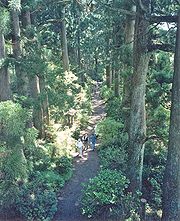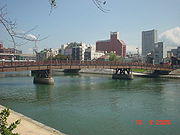
Kaido
Encyclopedia


Japan
Japan is an island nation in East Asia. Located in the Pacific Ocean, it lies to the east of the Sea of Japan, China, North Korea, South Korea and Russia, stretching from the Sea of Okhotsk in the north to the East China Sea and Taiwan in the south...
dating from the Edo period
Edo period
The , or , is a division of Japanese history which was ruled by the shoguns of the Tokugawa family, running from 1603 to 1868. The political entity of this period was the Tokugawa shogunate....
. Major examples include the Edo Five Routes
Edo Five Routes
The were the five major roads that started at Edo during the Edo period, the most important of which was the Tōkaidō, which linked Edo and Kyoto...
, all of which started at Edo
Edo
, also romanized as Yedo or Yeddo, is the former name of the Japanese capital Tokyo, and was the seat of power for the Tokugawa shogunate which ruled Japan from 1603 to 1868...
(modern-day Tokyo
Tokyo
, ; officially , is one of the 47 prefectures of Japan. Tokyo is the capital of Japan, the center of the Greater Tokyo Area, and the largest metropolitan area of Japan. It is the seat of the Japanese government and the Imperial Palace, and the home of the Japanese Imperial Family...
). Minor examples include sub-routes such as the Hokuriku Kaidō and the Nagasaki Kaidō
Nagasaki Kaido
The was a road across Kyūshū from Kokura to Nagasaki, used by daimyo for the sankin kotai, and also by the Dutch traders at Nagasaki on whom a similar obligation of visiting the Shogun was imposed...
.
Kaidō, however, do not include San'yōdō
San'yodo
is a Japanese term denoting both an ancient division of the country and the main road running through it. The San'yōdō corresponds for the most part with the modern conception of the San'yō region,San'yō translates to "the sunlight-side of a mountain", while dō, depending on the context, can mean...
, San'indō
San'indo
is a Japanese term denoting both an ancient division of the country and the main road running through it. San'in translates to "the shaded side of a mountain", while dō, depending on the context, can mean either a road, or a circuit, in the sense of delineating a region...
, Nankaidō
Nankaido
The , literally meaning "southern sea road," is a Japanese term denoting both an ancient division of the country and the main road running through it. The road connected provincial capitals in this region...
and Saikaidō
Saikaido
, literally meaning "western sea circuit," is a Japanese term denoting both an ancient division of the country and the main road running through it. Saikaido was one of the main circuits of the Gokishichidō system, which was originally established during the Asuka Period.This name identified the...
, which were part of the even more ancient system of Yamato government called Gokishichidō
Gokishichido
was the name for ancient administrative units organized in Japan during the Asuka Period , as part of a legal and governmental system borrowed from the Chinese...
. These names were used for administrative units, and the roads within these units.
Many highway
Highway
A highway is any public road. In American English, the term is common and almost always designates major roads. In British English, the term designates any road open to the public. Any interconnected set of highways can be variously referred to as a "highway system", a "highway network", or a...
s and railway lines in modern Japan follow the ancient routes and carry the same names. The early roads radiated from the capital at Nara
Nara, Nara
is the capital city of Nara Prefecture in the Kansai region of Japan. The city occupies the northern part of Nara Prefecture, directly bordering Kyoto Prefecture...
or Kyoto. Later, Edo was the reference, and even today Japan reckons directions and measures distances along its highway
Highway
A highway is any public road. In American English, the term is common and almost always designates major roads. In British English, the term designates any road open to the public. Any interconnected set of highways can be variously referred to as a "highway system", a "highway network", or a...
s from Nihonbashi
Nihonbashi
, or Nihombashi, is a business district of Chūō, Tokyo, Japan which grew up around the bridge of the same name which has linked two sides of the Nihonbashi River at this site since the 17th century. The first wooden bridge was completed in 1603, and the current bridge made of stone dates from 1911...
in Chūō, Tokyo
Chuo, Tokyo
is one of the 23 special wards that form the heart of Tokyo, Japan. The ward refers to itself as Chūō City in English.Its Japanese name literally means "Central Ward," and it is historically the main commercial center of Tokyo, although Shinjuku has risen to challenge it since the end of World War II...
.
The GokaidōEdo Five RoutesThe were the five major roads that started at Edo during the Edo period, the most important of which was the Tōkaidō, which linked Edo and Kyoto...
The five main kaidō from Nihonbashi in Edo were:- TōkaidōTokaido (road)The ' was the most important of the Five Routes of the Edo period, connecting Edo to Kyoto in Japan. Unlike the inland and less heavily travelled Nakasendō, the Tōkaidō travelled along the sea coast of eastern Honshū, hence the route's name....
(東海道) to KyotoKyotois a city in the central part of the island of Honshū, Japan. It has a population close to 1.5 million. Formerly the imperial capital of Japan, it is now the capital of Kyoto Prefecture, as well as a major part of the Osaka-Kobe-Kyoto metropolitan area.-History:...
along the coastline - NakasendōNakasendoThe , also called the , was one of the five routes of the Edo period, and one of the two that connected Edo to Kyoto in Japan. There were 69 stations between Edo and Kyoto, crossing through Musashi, Kōzuke, Shinano, Mino and Ōmi provinces...
(中山道) to KyotoKyotois a city in the central part of the island of Honshū, Japan. It has a population close to 1.5 million. Formerly the imperial capital of Japan, it is now the capital of Kyoto Prefecture, as well as a major part of the Osaka-Kobe-Kyoto metropolitan area.-History:...
through the mountains - Kōshū KaidōKoshu KaidoThe was one of the five routes of the Edo period and it was built to connect Edo with Kai Province in modern-day Yamanashi Prefecture, Japan. The route continues from there to connect with the Nakasendō's Shimosuwa-shuku in Nagano Prefecture...
(甲州街道) to KōfuKofu, Yamanashiis the capital city of Yamanashi Prefecture in Japan.As of May 1, 2011, the city had a estimate population of 197,540, with 85,794 households. The total area is 212.41 km².-History:Kōfu's name means "capital of Kai Province"... - Ōshū KaidōOshu KaidoThe was one of the five routes of the Edo period and it was built to connect Edo with Mutsu Province and the present-day city of Shirakawa, Fukushima Prefecture, Japan...
(奥州街道) to ShirakawaShirakawa, Fukushimais a city in Fukushima, Japan. It is located in the southern portion of the prefecture.The 2003 estimated population was 48,297 and the density in that year was 410.44 persons per km². The total area was 117.67 km²...
and other places of northern Japan - Nikkō KaidōNikko KaidoThe was one of the five routes of the Edo period and it was built to connect Edo with the Nikkō Tōshō-gū, which is located in the present-day city of Nikkō, Tochigi Prefecture, Japan. It was established in 1617 by Tokugawa Ieyasu, in order for him to have a smoother route to the shrine...
(日光街道) to NikkōNikko, Tochigiis a city in the mountains of Tochigi Prefecture, Japan. Approximately 140 km north of Tokyo and 35 km west of Utsunomiya, the capital of Tochigi Prefecture, it is a popular destination for Japanese and international tourists...
Lodgings
At various times, the government established post stations (shukubaShukuba
were post stations during the Edo period in Japan, generally located on one of the Edo Five Routes or one of its sub-routes. They were also called shukueki . These post stations were places where travelers could rest on their journey around the nation...
) along the roads. These had lodgings for travelers and grew as commercial centers. These former post towns, along with castle and harbor towns, form a major category of cities in Japan.
Cultural References to Kaidō
Kaidō figure prominently in Japanese culture. The poet Matsuo BashōMatsuo Basho
, born , then , was the most famous poet of the Edo period in Japan. During his lifetime, Bashō was recognized for his works in the collaborative haikai no renga form; today, after centuries of commentary, he is recognized as a master of brief and clear haiku...
memorialized his travels along the Ōshū Kaidō (and elsewhere) in the book Oku no Hosomichi
Oku no Hosomichi
, translated alternately as The Narrow Road to the Deep North and The Narrow Road to the Interior, is a major work by the Japanese poet Matsuo Bashō considered "one of the major texts of classical Japanese literature."...
. A set of woodblock prints
Ukiyo-e
' is a genre of Japanese woodblock prints and paintings produced between the 17th and the 20th centuries, featuring motifs of landscapes, tales from history, the theatre, and pleasure quarters...
by Hiroshige
Hiroshige
was a Japanese ukiyo-e artist, and one of the last great artists in that tradition. He was also referred to as Andō Hiroshige and by the art name of Ichiyūsai Hiroshige ....
forms a travelogue of the Tōkaidō. Daimyō
Daimyo
is a generic term referring to the powerful territorial lords in pre-modern Japan who ruled most of the country from their vast, hereditary land holdings...
, making the required sankin kotai
Sankin kotai
was a policy of the shogunate during most of the Edo period of Japanese history. The purpose was to control the daimyo. In adopting the policy, the shogunate was continuing and refining similar policies of Toyotomi Hideyoshi. In 1635, a law required sankin kōtai, which was already an established...
trip between their han
Han (Japan)
The or domain was the name of the estate belonging to a warrior in Japan after the 17th century. The fiefs of the daimyos of the samurai class of Japan during the Edo period were called han.-Edo period:...
and Edo, also traveled along the kaidō and stayed at post stations. Some woodblock prints show their stately processions. The Bunraku
Bunraku
, also known as Ningyō jōruri , is a form of traditional Japanese puppet theater, founded in Osaka in 1684.Three kinds of performers take part in a bunraku performance:* Ningyōtsukai or Ningyōzukai—puppeteers* Tayū—the chanters* Shamisen players...
play Kanadehon Chūshingura, the fictionalized account of the true story of the Forty-seven Ronin
Forty-seven Ronin
The revenge of the , also known as the Forty-seven Samurai, the Akō vendetta, or the took place in Japan at the start of the 18th century...
, has several scenes set along various kaidō.

